A pull-up bar is one of the most awesomely versatile tools for building muscle and strength.
But many think a pull-up bar is just for your back and biceps. Think again.
Believe it or not, there are many exercises that you can do with the pull-up bar to train your shoulder, arms, and core muscles, including abs & obliques, and glutes.
In this post, I will share 12 of my favorite pull-up bar exercises that don’t just work your back—you can hit practically every muscle group.
The best part is that most of these exercises only require a pull-up bar. That means you can get an amazing full-body workout anytime, anywhere—at home, the gym, or even a local park.
Let’s get started!
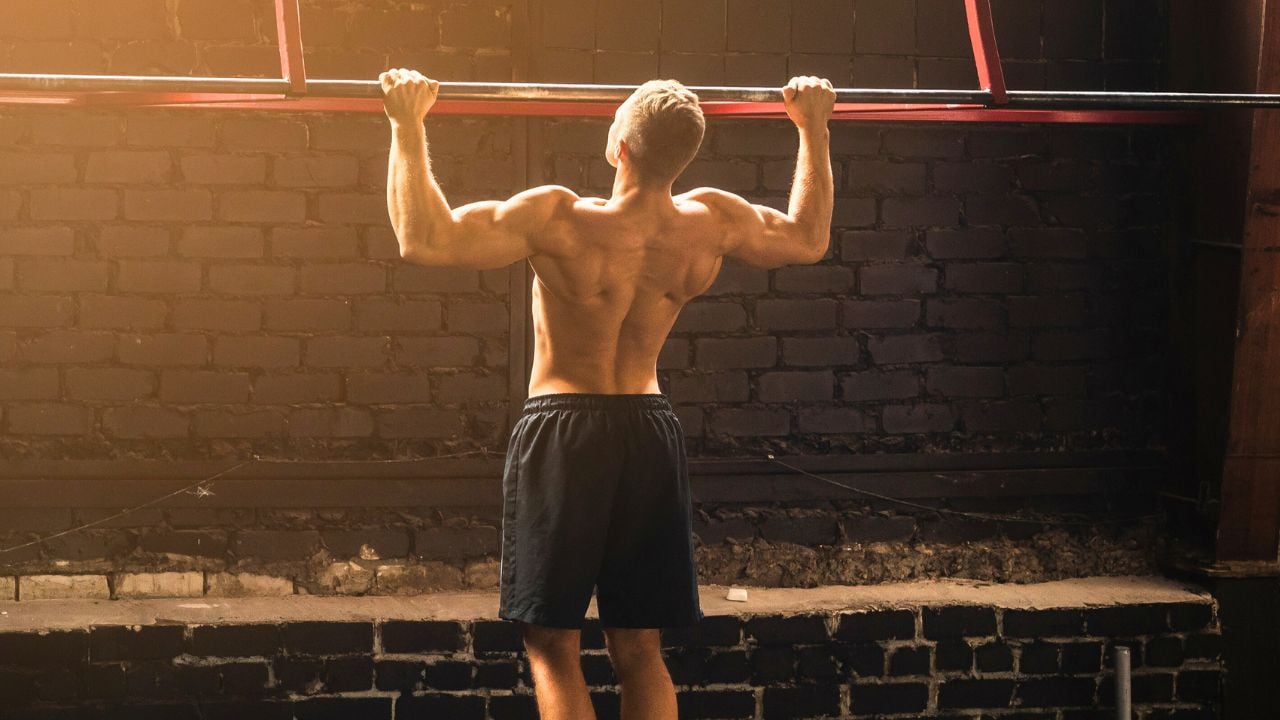
- 12 Pull-Up Bar Exercises You Need To Train Entire Body
- 1. Pull-Ups
- 2. Chin-Ups
- 3. Hanging Knee Raise
- 4. Hanging Straight Leg Raise
- 5. Pull Bar Windshield Wiper
- 6. Hammer (Neutral) Grip Pull-Ups
- 7. L-Sit Pull-Ups
- 8. Scapular Pull-Ups
- 9. Commando Pull Ups
- 10. Muscle-Ups
- 11. Jumping Pull-Ups
- 12. Archer Pull Up
- Takeaways
12 Pull-Up Bar Exercises You Need To Train Entire Body
These 12 pull-up bar exercises will work your entire body functionally, multi-planarly. From grip-crushing pulls to deep core contractions and powerful lower body movements, you’ll build strength where it matters most.
Add these to your routine to build a physique that looks as capable as it truly is.
1. Pull-Ups
Pull-ups are one of the best ways to sculpt a strong, powerful upper body.
The main target? Your back muscles, particularly the latissimus dorsi (those fancy wing-shaped muscles). But the party doesn’t stop there.
Pull-ups also engage your biceps, shoulders, forearms, and even your core for stability.
You can adjust your grip width and hand position to target different muscles or try progressions to make the exercise easier or harder.
I enjoy this exercise because I feel that my back is completely trained after doing it.
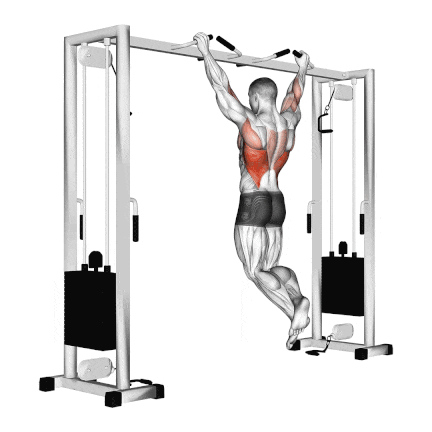
How To Do
- Grab the bar with an overhand grip, hands slightly wider than shoulder-width apart.
- Hang straight from the bar with your arms fully extended and your core engaged.
- Think of pulling your belly button towards your spine.
- Now comes the fun part. Initiate the pull by squeezing your shoulder blades together. Aim to get your chin over the bar.
- Slowly lower yourself back to the starting position in a controlled manner.
2. Chin-Ups
Chin-ups and pull-ups are often used interchangeably. However, they do have some differences.
Both exercises target the upper body, specifically the back muscles, such as the lats, trapezius, rhomboids, shoulders, and arms.
A chin-up is an exercise in which the palms face toward the body while gripping the bar (underhand or supinated grip). This grip targets the biceps more than the back and shoulders.
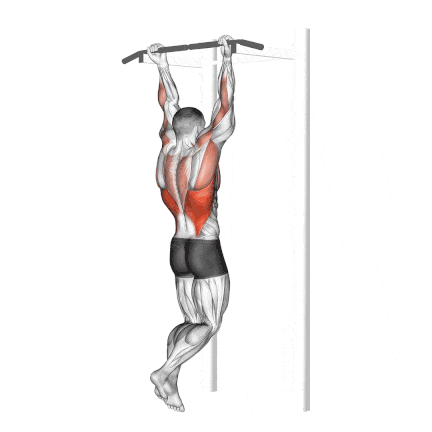
How To Do It
- Grip the pull-up bar with your palms facing toward you and use a narrow grip.
- Hang from the bar with your arms fully extended and shoulders pulled down and back.
- Engage your core and keep your body straight from your head to your heels.
- Pull your body up towards the bar by flexing your elbows and bringing your chest towards the bar.
- Keep your elbows close to your body as you pull yourself up.
- Once your chin is above the bar, hold for a moment and lower yourself slowly.
3. Hanging Knee Raise
The hanging knee raise is one of the best abs exercises that people do at the gym for building strength in the hip flexors and developing the six-pack and stronger core.
It is a compound exercise where you raise your knees towards your chest while hanging from a pull-up bar.
It primarily targets the lower abs, but also works the hip flexors, obliques, and forearms. It is one of my favorite exercises, and I must perform it during my ab workout.
A recent study looked at plank and bilateral leg raise exercises and found some interesting insights.
- The plank more effectively activated the internal oblique muscles (side abs).
- On the other hand, the bilateral leg raise was better at working the rectus abdominis (your “six-pack” muscles).

How To Do It
- Grab the bar with an overhand grip slightly wider than shoulder-width.
- Hang from the bar with arms extended, legs straight down, and core tight.
- Squeeze your abs and use your hip flexors to raise your knees toward your chest.
- Keep your spine neutral (don’t arch your back).
- Try to bring your knees as close to your chest as possible.
- Slowly lower your legs back to the starting position in a controlled manner.
4. Hanging Straight Leg Raise
Hanging straight leg raises is better for people who want to work their core and hip muscles more. It requires more strength and control than the hanging knee lift.
It primarily works the abs and hip flexors. Likewise, it is a great addition to any fitness routine for overall core strength, spine health, and mobility.
In fact, studies have shown that hanging leg raises activated the rectus abdominis by 100% and activated the oblique muscles by 88%.
When you master the hanging straight leg raise, you can try more advanced core exercises like hanging toes-to-bar.

How To Do It
- Hang from a pull-up bar with an overhand grip, shoulders engaged, and core braced.
- Keep your legs straight, and raise them up towards the ceiling by driving from the hip flexors and lower abs.
- Raise your legs as high as you can control while avoiding any swinging or arching of the lower back.
- Pause briefly at the top of the motion.
- Slowly lower back down under complete control.
5. Pull Bar Windshield Wiper
Hanging windshield wipers are an advanced core exercise that combines strength, coordination, and controlled rotation.
Hang from a pull-up bar and swing your legs from side to side in a controlled motion, like a windshield wiper.
This exercise mainly works the obliques, but it also works your abs, lower back muscles, and hip flexor muscles to stabilize and rotate your body.
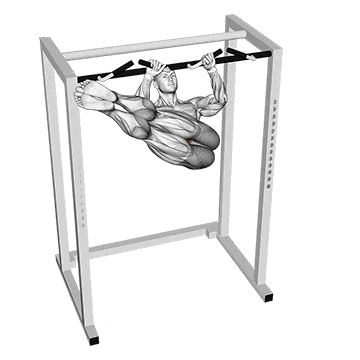
How To Do It
- Grab a bar with an overhead grip, with the hands slightly wider than shoulder-width.
- Keep your core and glutes tight to keep your back and hips in the correct position.
- Lift your legs towards the bar. Keep your arms and legs straight.
- Now, your legs are perpendicular to your torso.
- Now, rotate your legs to one side until they are parallel with the floor, roughly 90 degrees.
- Slowly and with control, rotate your legs to the other side.
- Keep your legs as straight as possible.
6. Hammer (Neutral) Grip Pull-Ups
In neutral-grip pull-ups, the hands are positioned with a parallel grip (palms facing each other) on the bar or a parallel bar.
This variation slightly shifts the focus away from the back and places greater emphasis on your biceps, brachialis (elbow flexor), and forearm muscles.
The neutral grip may be more comfortable for those with wrist or shoulder sensitivities than a traditional overhand pull-up.
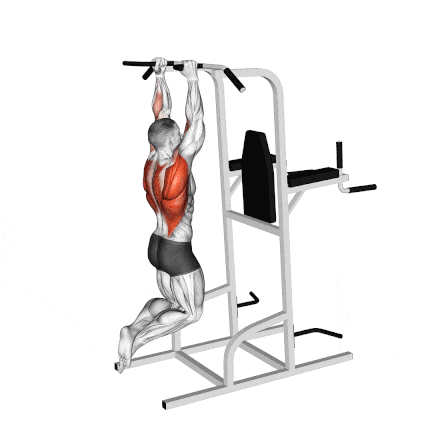
How To Do It
- Grasp the parallel bars with palms facing each other.
- Hang from the bars with your arms fully extended and your body in a straight line from head to heels.
- Engage your core muscles and retract your shoulder blades as you pull yourself upward until your chin is above the bars.
- Pause briefly at the top of the movement, then slowly lower yourself back down to the starting position.
- Try to do 3 sets of 8–12 repetitions.
7. L-Sit Pull-Ups
The L-sit pull-up, executed on parallel bars, adds a whole new dimension to the workout.
While pull-ups target the upper body, the L-sit is a brutal core challenge. You’ve likely seen this gymnastic move – the body held in an ‘L’ shape with legs extended.
The L-sit strengthens your core and hip flexors. It also strengthens your legs. Plus, the intense core work will give you those coveted, well-defined abs.
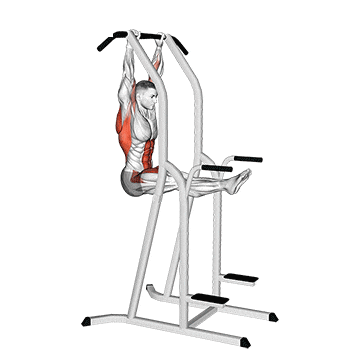
How To Do It
- Hang from a pull-up bar with an overhand grip.
- Engage your core and raise your legs out in front of you.
- Keep them straight to get into an L-sit position.
- Pull your body straight until your chin clears the bar.
- Lower back down with control, avoiding any swinging or kipping.
- Repeat.
8. Scapular Pull-Ups
Scapular pull-ups, are among the best exercises for strengthening the upper back muscles.
Adding a scapular pull-up to your workout routine can help you build more muscle and strengthen weak spots in your shoulders and back.
The main difference between pull-ups and scapular pull-ups is that conventional pull-ups use your arms to pull you up. On the other hand, scap pull-ups work your back and use your arms isometrically, and do little range of motion.
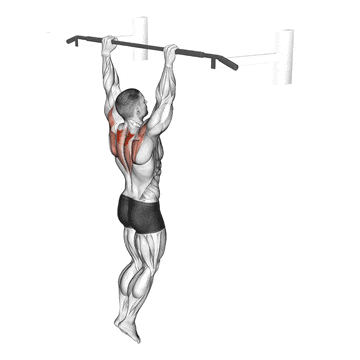
How To Do It
- Start with your normal pull-up position.
- Keep your abs and glutes tight while you are hanging from the bar.
- Take a breath and initiate the scapular pull-up by bringing your shoulders back and down. Keep your arms straight.
- From a full hang, with just slightly shrugged shoulders.
- You want to draw the scapula down and together so your body is raised a little, but you don’t want to bend your arms and pull like you would with a regular pull-up.
- Hold the retracted position for a second or two, making sure to feel your back muscles working.
- Then, return to the starting position. The range of motion is only a few inches.
9. Commando Pull Ups
Commando pull-ups are similar to the close-grip chin-ups but with a more specific grip.
In this variation, the hands are positioned with a narrow grip, mimicking the grip of a hockey stick.
It emphasizes the biceps and forearms more than the back. It can also be a great way to improve grip strength.
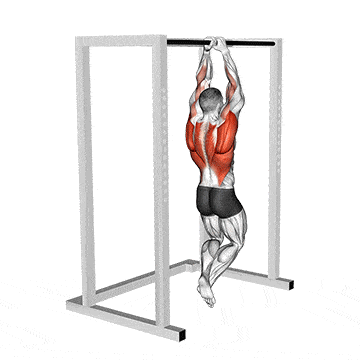
How To Do It
- Grip the bar with one hand facing forward and the other facing backward, about shoulder-width apart.
- Begin the exercise by pulling yourself up with the hand that is facing forward.
- Once your chin is above the bar, switch your grip so that the hand that was facing forward is now facing backward, and the hand that was facing backward is now facing forward.
- Lower yourself down to the starting position with your new grip.
- Repeat the exercise with the opposite hand leading.
10. Muscle-Ups
The muscle-up is a gymnastics-inspired exercise and a true test of strength and coordination. It’s a combination of two foundational movements:
- The Pull-Up: You start by pulling yourself up to the bar, just like a standard pull-up.
- The Dip: Once your chest reaches bar height, you transition into a dip-like motion, pressing yourself up and over the bar.
Muscle-ups build strength throughout your back, shoulders, chest, triceps, and biceps – essentially, your entire upper body.

How To Do It
- You can choose between a false grip (thumbs not wrapped around the bar) or a full grip on the pull-up bar.
- Your hands should be shoulder-width apart or slightly wider.
- Hang with arms extended, legs straight and together, and core fully engaged.
- Pull yourself upwards quickly and powerfully, using your back and arms. As you pull, let your legs swing forward slightly and lean back.
- Continue to pull until your chest is above the bar. Now, lean forward and quickly push your upper body forward.
- Straighten your arms like you’re finishing a dip, with your shoulders slightly ahead of the bar.
- Slowly lower by bending your elbows and moving your chest back towards the bar.
- Let your legs swing forward again as you reach the bar with your chest.
- Lower yourself back to the starting position.
11. Jumping Pull-Ups
Jumping pull-ups are a dynamic exercise that combines the explosive power of a jump with the strength-building benefits of a pull-up.
They challenge your cardiovascular system, build strength in multiple muscle groups, improve joint mobility, and even enhance your coordination.
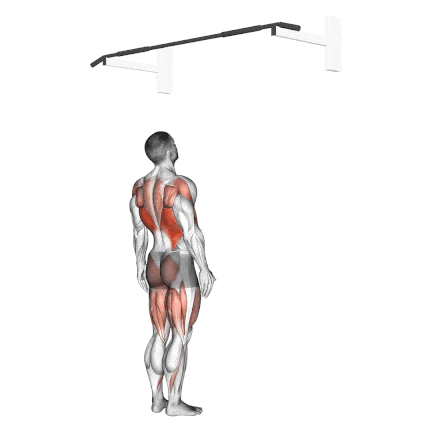
How to Do It
- Stand beneath a pull-up bar at a height that allows you to jump and comfortably grip the bar.
- Aim for a distance of 2-3 feet below your maximum jump height.
- Prepare to jump by spreading your hands upwards towards the bar.
- Engage your hips and knees, and explode upwards to reach the bar.
- Grip the bar firmly with an even shoulder-width hand position.
- Pull yourself upwards, using your back, biceps, forearms, and core muscles, until your chin reaches or surpasses the bar.
- Slowly lower yourself back down until your arms are fully extended.
- Release your grip from the bar, drop down, and jump again to initiate the next repetition.
12. Archer Pull Up
Think of an archer pull-up as almost a self-assisted one-arm pull-up. It’s a great way to dramatically increase the intensity of a standard pull-up without adding weight.
This exercise intensely develops strength in one arm at a time, targeting the lats, biceps, forearms, and shoulders. It helps correct strength imbalances.
Note: Before attempting the advanced variations, you are recommended to master the standard pull-ups.
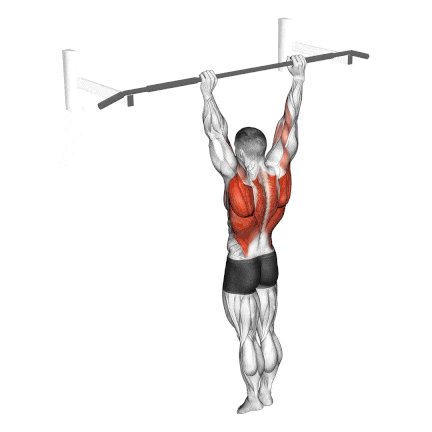
How To Do It
- Grab the pull-up bar with an overhand grip.
- Position one hand slightly wider than shoulder-width and the other hand closer to your body.
- Pull yourself upwards with the wider grip arm.
- As you pull, slightly twist and shift your weight towards the bent arm.
- Aim to get your chin above the bar on the side of the bent arm.
- Your fully extended arm may open slightly and roll over the bar. Imagine yourself drawing a bow and arrow with your body as the bow.
- Slowly lower yourself back down, maintaining the archer position as long as possible.
- After completing reps on one side, switch arm positions and repeat the movement on the other side.
Takeaways
Okay, now that you have a whole arsenal of pull-up bar exercises, you should try them. They engage your core, arms, and shoulders.
Change your hand position, add leg raises, or try dynamic exercises to keep your workouts interesting and challenging.
And the best part?
Through consistent practice, you can progress from basic variations to more advanced moves. Pick a few exercises from this post that interest you and try them out this week.
Don’t worry – use bands or try negatives if needed, and focus on getting a little stronger each time you hit the bar.
I’d love to hear about your experience!
Leave a comment below and tell me about your pull-up bar adventures. What are your favorite exercises so far? What have you found challenging?
References
- Park DJ, Park SY. Which trunk exercise most effectively activates abdominal muscles? A comparative study of plank and isometric bilateral leg raise exercises. J Back Musculoskelet Rehabil. 2019;32(5):797-802.
- Davies G, Riemann BL, Manske R. CURRENT CONCEPTS OF PLYOMETRIC EXERCISE. Int J Sports Phys Ther. 2015;10(6):760-786.
- Hewit JK, Jaffe DA, Crowder T. A comparison of muscle activation during the pull-up and three alternative pulling exercises. J. Phys. Fitness, Med. Treat. Sport. 2018;5(4):1-7.
- Leslie KL, Comfort P. The effect of grip width and hand orientation on muscle activity during pull-ups and the lat pull-down. Strength & Conditioning Journal. 2013 Feb 1;35(1):75-8.

Manish is a NASM-certified fitness and nutrition coach with over 10 years of experience in weight lifting and fat loss fitness coaching. He specializes in gym-based training and has a lot of knowledge about exercise, lifting technique, biomechanics, and more.
Through “Fit Life Regime,” he generously shares the insights he’s gained over a decade in the field. His goal is to equip others with the knowledge to start their own fitness journey.
